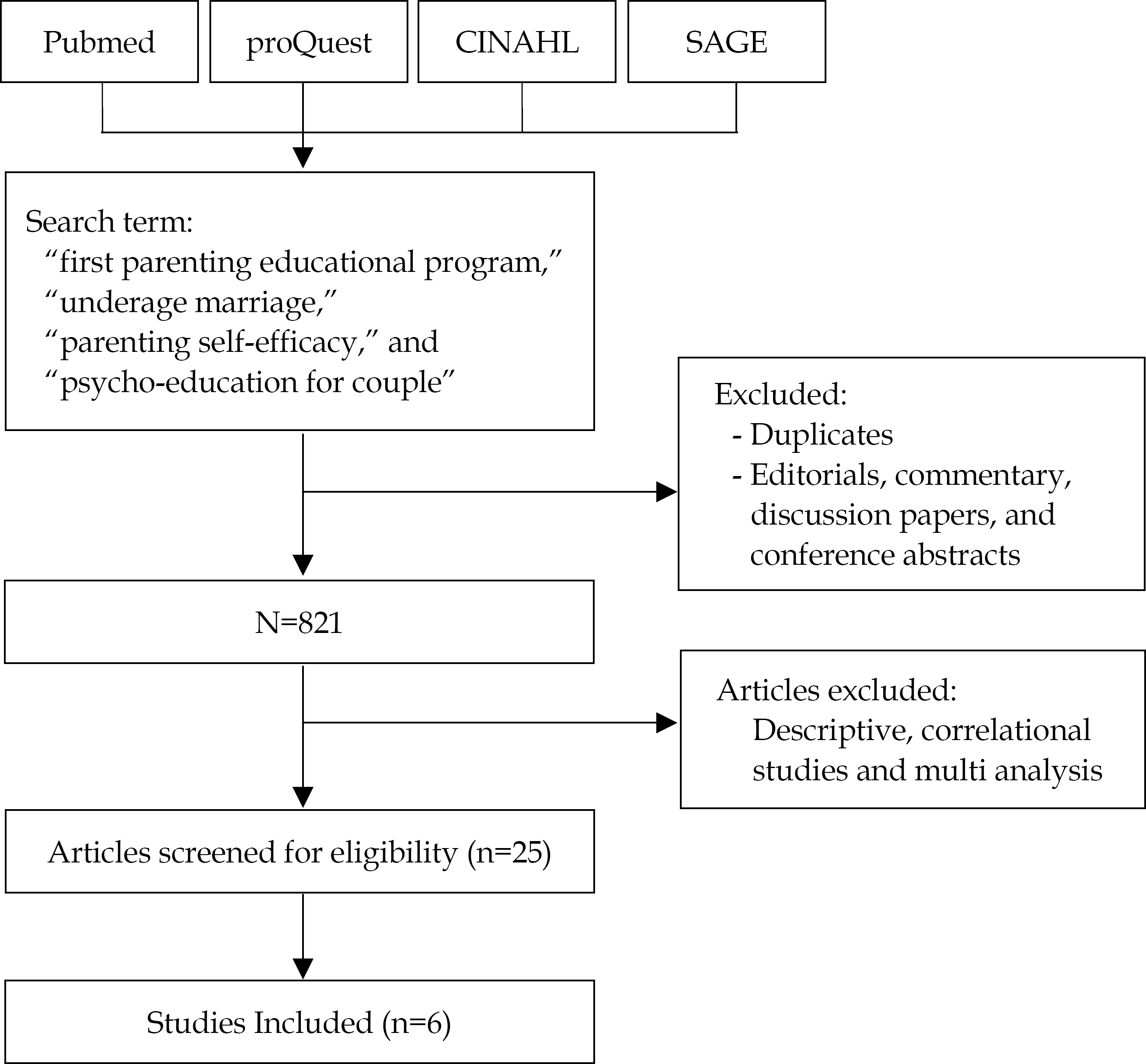Abstract
Purpose
The purpose of this study was to identify the latest evidence for interventions involving adolescent newlyweds, and the feasibility of premarital coaching (PMC).
Methods
A narrative literature review design carried out through related studies was used for the present literature review. A diverse search from several databases was performed to create a critical appraisal and to develop a more integrated model for the PMC program. Studies that empirical, written in English, peer-reviewed, and published during 2008∼2017 were included.
Results
Six articles were selected for the review. The principal findings identified three major themes including underage period as a high-risk for marriage, development tasks of the newly married spouse, parenting self-efficacy and the psycho-educational approach of PMC to enhance parenting knowledge, skills, and readiness.
Go to : 
References
1. Ministry of Health Republic (ID). 2015 Profil kesehatan Indonesia [2015 Health profile Indonesia] [Internet]. Jakarta: Ministry of Health (ID);2016. [cited 2018 Jan 25].p. 403. p. Available from:. http://www.depkes.go.id/resources/download/pusdatin/profil-kesehatan-indonesia/profil-kesehatan-Indonesia-2015.pdfIndonesian.
2. Sammon EM, Martinez M, Jagmag M, Wahyudi R. Overview of promising practices in adolescent programming in Indonesia by UNICEF (and other partners) [Internet]. [place unknown]: Oxford Policy Management;. 2017. Jul 14 [cited 2018 Jan 25].62. p. Available from:. https://www.unicef.org/indonesia/Overview_of_Promising_Practices_in_Adolescent_Programming_in_Indonesia.pdf.
3. Statistics Indonesia; National Population and Family Planning Board (ID); Ministry of Health (ID); ICF International. Indonesia demographic and health survey 2012 [Internet]. Jakarta (ID): Statistics Indonesia;2013. [cited 2018 Jan 25].p. 544. p. Available from:. https://www.dhsprogram.com/pubs/pdf/FR275/FR275.pdf.
4. DeVito J. How adolescent mothers feel about becoming a parent. J Perinat Educ. 2010 Spring; 19(2):25–34. https://doi.org/10.1624/105812410X495523.

5. Meliala A. Succesful Parenting. Bogor: Bypass;2012. p. 124. p.
6. Bloomfield L, Kendall S. Testing a parenting programme evaluation tool as a pre-and post-course measure of parenting self-efficacy. J Adv Nurs. 2007 Dec; 60(5):487–93. https://doi.org/10.1111/j.1365–2648.2007.04420.x.
7. Kalamar AM, Lee-Rife S, Hindin MJ. Interventions to prevent child marriage among young people in low-and middle-income countries: a systematic review of the published and gray literature. J Adolesc Health. 2016 Sep; 59:(. (3 Suppl):):. S16–21. https://doi.org/10.1016/j.jadohealth.2016.06.015.
8. Lohmann RC. Teen anxiety: a CBT and ACT activity resource book for helping anxious adolescents. London (UK): Jessica Kingsley Publishers;2014. p. 240. p.
9. Casey BJ, Ruberry EJ, Libby V, Glatt CE, Hare T, Soliman F, et al. Transitional and translational studies of risk for anxiety. Depress Anxiety. 2011 Jan; 28(1):18–28. https://doi.org/10.1002%2Fda.20783.

10. Partridge BC. Adolescent psychological development, parenting styles, and pediatric decision making. J Med Philos. 2010 Oct; 35(5):518–25. https://doi.org/10.1093/jmp/jhq044.

11. Halford WK, O'donnell C, Lizzio A, Wilson KL. Do couples at high risk of relationship problems attend premarriage education? J Fam Psychol. 2006 Mar; 20(1):160–3. https://doi.org/10.1037/0893–3200.20.1.160.

12. Ministry of Health (ID); The United Nations Children's Fund. Child marriage in Indonesia: progress on pause [Internet]. Jakarta (ID): Ministry of Health (ID);2016. [cited 2018 Jan 25].p. 7. p. Available from:. https://www.unicef.org/indonesia/UNICEF_Indonesia_Child_Marriage_Reserach_Brief_.pdf.
13. United Nations Children's Fund. Legal protection from violence: analysis of domestic laws related to violence against children in ASEAN member States [Internet]. Bangkok: UNICEF EAPRO;2015. [cited 2018 Jan 25].p. 276. p. Available from:. https://www.unicef.org/eapro/ASEAN_VAC(1).pdf.
14. Rabi A, Rumble L, Irdiana N, Helscher P, Suharti. The cost of inaction: child and adolescent marriage in Indonesia [Internet]. Paper presented at: 10th ISPCAN Asia Pacific Regional Conference on Child Abuse and Neglect;. 2015. Oct 25–27; Kuala Lumpur, Malaysia. Available from:. https://www.researchgate.net/profile/Lauren_Rumble/publication/283084606_The_cost_of_inaction_Child_marriage_in_Indonesia/links/5629d50608ae22b17030eaef/The-cost-of-inaction-Child-marriage-in-Indonesia.
15. Kaakinen JR, Coehlo DP, Steele R, Tabacco A, Hanson SMH. Family health care nursing: theory, practice, and research. 5th ed.Philadelphia(PA): F.A. Davis;2014. p. 649. p.
16. Lavenda O, Kestler-Peleg M. Parental self-efficacy mitigates the association between low spousal support and stress. Psychiatry Res. 2017 Oct; 256:228–30. https://doi.org/10.1016/j.psychres.2017.06.060.

17. Cohen SR, Holloway SD, Domínguez-Pareto I, Kuppermann M. Support and self-efficacy among Latino and White parents of children with ID. Am J Intellect Dev Disabil. 2015 Jan; 120(1):16–31. https://doi.org/10.1352/1944–7558–120.1.16.

18. Ebstrup JF, Eplov LF, Pisinger C, Jorgensen T. Association between the Five Factor personality traits and perceived stress: is the effect mediated by general self-efficacy? Anxiety Stress Coping. 2011 Jul; 24(4):407–19. https://doi.org/10.1080/10615806.2010.540012.

19. Bandura A. Self-efficacy: toward a unifying theory of behavioral change. Psychol Rev. 1977 Mar; 84(2):191–215. https://doi.org/10.1037/0033–295X.84.2.191.

20. Raynor PA. An exploration of the factors influencing parental self-efficacy for parents recovering from substance use disorders using the social ecological framework. J Addict Nurs. 2013 Apr-Jun; 24(2):91–9. https://doi.org/10.1097/JAN.0b013e3182922069.

21. Holub CK, Kershaw TS, Ethier KA, Lewis JB, Milan S, Ickovics JR. Prenatal and parenting stress on adolescent maternal adjustment: identifying a high-risk subgroup. Matern Child Health J. 2007 Mar; 11(2):153–9. https://doi.org/10.1007/s10995–006–0159-y.

22. Leahy-Warren P, McCarthy G. Maternal parental self-efficacy in the postpartum period. Midwifery. 2011 Dec; 27(6):802–10. https://doi.org/10.1016/j.midw.2010.07.008.

23. de Oliveira PS, Nene M. Nursing care needs in the postpartum period of adolescent mothers: systematic review. J Nurs UFPE. 2014 Nov; 8(11):3953–61. https://doi.org/10.5205/reuol.6679–58323–1-ED.0811201419.
24. Weiss ME, Lokken L. Predictors and outcomes of postpartum mothers' perceptions of readiness for discharge after birth. J Obstet Gynecol Neonatal Nurs. 2009 Jul-Aug; 38(4):406–17. https://doi.org/10.1111/j.1552–6909.2009.01040.x.

25. Buchko BL, Gutshall CH, Jordan ET. Improving quality and efficiency of postpartum hospital education. J Perinat Educ. 2012 Fall; 21(4):238–47. https://doi.org/10.1891/1058–1243.21.4.238.

26. Setiawati N, Setyowati , Budiati T. SETIA Health education set enhances knowledge, attitude, and parenting self-efficacy score in postpartum adolescent mothers. Compr Child Adolesc Nurs. 2017; 40(sup1):114–27. https://doi.org/10.1080/24694193.2017.1386979.

27. Guimond AB, Wilcox MJ, Lamorey SG. The Early Intervention Parenting Self-Efficacy Scale (EIPSES): scale construction and initial psychometric evidence. J Early Interv. 2008 Sep; 30(4):295–320. https://doi.org/10.1177/1053815108320814.
28. Jamal L. Teen mother perceptions of support program influences on self-efficacy, parenting-efficacy, and school success [dissertation]. Omaha, NE: College of Saint Mary;2014. p. 184. p.
29. Petch J, Halford WK, Creedy DK, Gamble J. Couple relationship education at the transition to parenthood: A window of opportunity to reach high-risk couples. Fam Process. 2012 Dec;. 51(4):498–511. https://doi.org/10.1111/j.1545–5300.2012.01420.x.
Go to : 
Table 1.
Journal Analysis of Premarital Programs for Underage Couples
Table 2.
Educational Content Summary of the Selected Interventions and Evaluations




 PDF
PDF ePub
ePub Citation
Citation Print
Print



 XML Download
XML Download